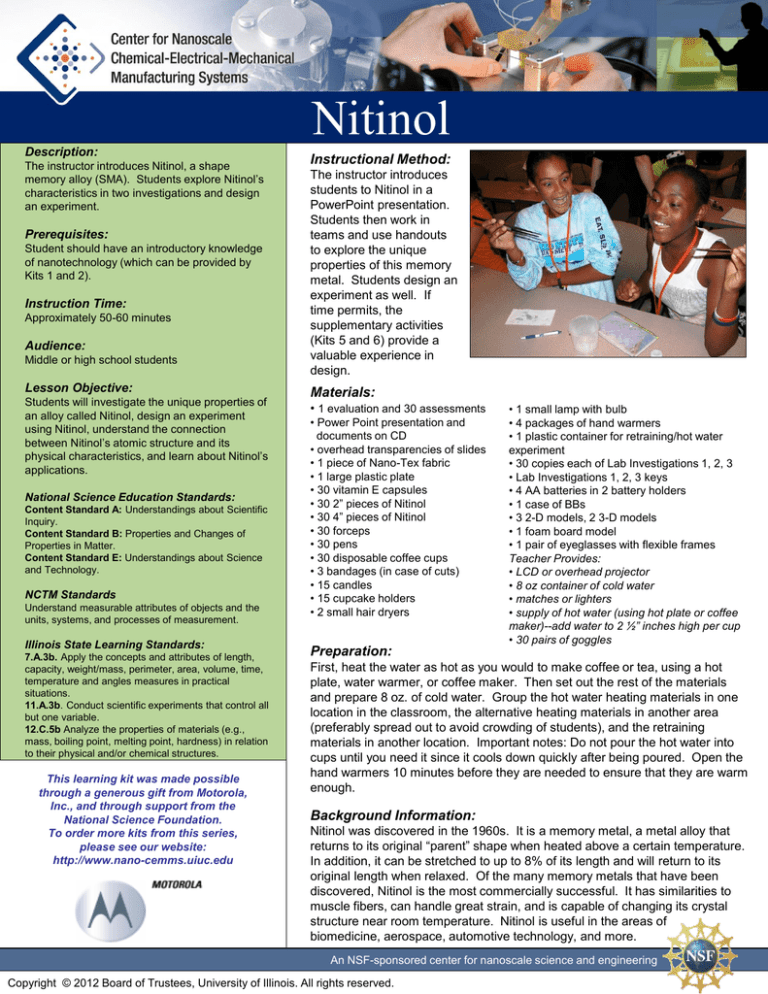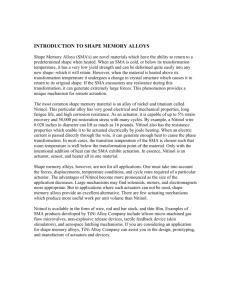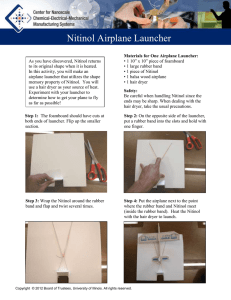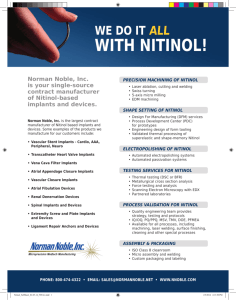
Nitinol
Description:
The instructor introduces Nitinol, a shape
memory alloy (SMA). Students explore Nitinol’s
characteristics in two investigations and design
an experiment.
Prerequisites:
Student should have an introductory knowledge
of nanotechnology (which can be provided by
Kits 1 and 2).
Instruction Time:
Approximately 50-60 minutes
Audience:
Middle or high school students
Lesson Objective:
Students will investigate the unique properties of
an alloy called Nitinol, design an experiment
using Nitinol, understand the connection
between Nitinol’s atomic structure and its
physical characteristics, and learn about Nitinol’s
applications.
National Science Education Standards:
Content Standard A: Understandings about Scientific
Inquiry.
Content Standard B: Properties and Changes of
Properties in Matter.
Content Standard E: Understandings about Science
and Technology.
NCTM Standards
Understand measurable attributes of objects and the
units, systems, and processes of measurement.
Illinois State Learning Standards:
7.A.3b. Apply the concepts and attributes of length,
capacity, weight/mass, perimeter, area, volume, time,
temperature and angles measures in practical
situations.
11.A.3b. Conduct scientific experiments that control all
but one variable.
12.C.5b Analyze the properties of materials (e.g.,
mass, boiling point, melting point, hardness) in relation
to their physical and/or chemical structures.
This learning kit was made possible
through a generous gift from Motorola,
Inc., and through support from the
National Science Foundation.
To order more kits from this series,
please see our website:
http://www.nano-cemms.uiuc.edu
Instructional Method:
The instructor introduces
students to Nitinol in a
PowerPoint presentation.
Students then work in
teams and use handouts
to explore the unique
properties of this memory
metal. Students design an
experiment as well. If
time permits, the
supplementary activities
(Kits 5 and 6) provide a
valuable experience in
design.
Materials:
• 1 evaluation and 30 assessments
• Power Point presentation and
documents on CD
• overhead transparencies of slides
• 1 piece of Nano-Tex fabric
• 1 large plastic plate
• 30 vitamin E capsules
• 30 2” pieces of Nitinol
• 30 4” pieces of Nitinol
• 30 forceps
• 30 pens
• 30 disposable coffee cups
• 3 bandages (in case of cuts)
• 15 candles
• 15 cupcake holders
• 2 small hair dryers
Preparation:
• 1 small lamp with bulb
• 4 packages of hand warmers
• 1 plastic container for retraining/hot water
experiment
• 30 copies each of Lab Investigations 1, 2, 3
• Lab Investigations 1, 2, 3 keys
• 4 AA batteries in 2 battery holders
• 1 case of BBs
• 3 2-D models, 2 3-D models
• 1 foam board model
• 1 pair of eyeglasses with flexible frames
Teacher Provides:
• LCD or overhead projector
• 8 oz container of cold water
• matches or lighters
• supply of hot water (using hot plate or coffee
maker)--add water to 2 ½” inches high per cup
• 30 pairs of goggles
First, heat the water as hot as you would to make coffee or tea, using a hot
plate, water warmer, or coffee maker. Then set out the rest of the materials
and prepare 8 oz. of cold water. Group the hot water heating materials in one
location in the classroom, the alternative heating materials in another area
(preferably spread out to avoid crowding of students), and the retraining
materials in another location. Important notes: Do not pour the hot water into
cups until you need it since it cools down quickly after being poured. Open the
hand warmers 10 minutes before they are needed to ensure that they are warm
enough.
Background Information:
Nitinol was discovered in the 1960s. It is a memory metal, a metal alloy that
returns to its original “parent” shape when heated above a certain temperature.
In addition, it can be stretched to up to 8% of its length and will return to its
original length when relaxed. Of the many memory metals that have been
discovered, Nitinol is the most commercially successful. It has similarities to
muscle fibers, can handle great strain, and is capable of changing its crystal
structure near room temperature. Nitinol is useful in the areas of
biomedicine, aerospace, automotive technology, and more.
An NSF-sponsored center for nanoscale science and engineering
Copyright © 2012 Board of Trustees, University of Illinois. All rights reserved.
Safety:
This activity requires the use of very hot water and a candle flame. Students should use tongs when putting Nitinol in hot
water and pulling it out. They should not put their faces directly over the water, as the Nitinol may fly out or flick water
into their faces when it returns to its memory shape. Students should be careful when dealing with the batteries.
Students should wear safety goggles when working with the flame. The wires may be sharp; bandages are included in
case students cut themselves.
Presentation Details:
Slide 1 (Nitinol): Today we are going to be exploring a material called Nitinol.
Slide 2 (Objective): You will investigate the unique properties of an alloy called Nitinol, design an experiment using
Nitinol, learn about the connection between Nitinol’s atomic structure and its physical characteristics, and learn about
Nitinol’s applications.
Slide 3 (Nanotechnology): In the field of nanotechnology, some scientists and engineers develop smart materials.
Slide 4 (Smart materials): A smart material is any material that has been engineered at the nanoscale to perform
specific tasks.
Slide 5 (Smart fabrics): Nano-Tex is a company that has made a smart fabric that uses nanoscale structures to
change the physical properties of clothing. The structures are nanoscale-sized hairs (like cilia) that make clothes able to
wick water away and spread it out on the fabric to quickly dry. In the slide, you can see that the liquid does not get
absorbed by the fabric; instead, it stays on the fabric and does not stain it. (Demonstrate by putting the Nano-Tex fabric
on a plate and then pour water on the fabric. The water should not be immediately absorbed by the fabric.)
Slide 6 (Self-healing materials): Nancy Sottos and other scientists and engineers at the University of Illinois are
working on developing smart materials called self-healing materials. These materials can actually fix themselves!
Similar to the body’s ability to repair itself when damaged, self-healing materials are able to heal themselves. Think
about when you have cut yourself. The cut heals, right? These materials are designed to do the same. For example, if
you drop a delicate device like a cell phone on the ground, it may get a crack which can propagate and ruin the phone.
Have you or your parents ever destroyed a phone this way? Probably! If you drop your cell phone and it contains selfhealing materials, then you may able to keep it much longer before replacing it.
Slide 7 (How self-healing materials work): Imagine that we have enlarged the material in one of these self-healing
cell phones, so we are looking at it magnified many times. The material contains small capsules of the healing agent
and tiny pockets of a catalyst. Here are some capsules that represent the microcapsules of the healing agent. (Show a
Vitamin E capsule to students.) But these capsules are actually many times bigger than the microcapsules used in
Nancy Sottos’ research. (Pass the capsules and pens out to each student.) Take your capsule and pierce it with the end
of your pen. In the same way, if the material in the phone cracks (a), the capsules of healing agent are opened or
“pierced” and they fill the crack. Once the healing agent comes in contact with the catalyst (b), a chemical reaction
occurs which causes the agent to harden and fix the crack (c). This chemical reaction is very similar to mixing two
components together to make epoxy.
Slide 8 (Similar to epoxy): Epoxy is a hard substance that forms when one compound is mixed with a catalyst. This
woman is mixing the two components together. Once the A and B components come in contact with each other, the
chemical reaction occurs and the hardening begins. This is very similar to what happens when the self-healing agent
comes in contact with the catalyst from the previous slide.
Slide 9 (A smart alloy): Smart alloys are another type of smart material. Nitinol is one smart alloy. It is made of nickel
and titanium. It was first made in the late 1950s at the Naval Ordnance Laboratory. This is where the name comes from.
It consists of alternating atoms of nickel and titanium.
Slide 10 (Nitinol--a smart material?): How is Nitinol a smart material? I’m going to give you some materials to explore
this smart material. Each of you will receive a handout, a piece of 2” Nitinol, forceps, and a pen. You can share the
beaker of hot water with a partner. Follow the directions given to explore Nitinol. Write down your observations and
answer the questions. (Mention safety precautions. Fill each cup 2 ½” inches high with water.)
Slide 11 (Shape Memory Alloy (SMA)): Through your investigation, you have discovered that Nitinol is a shape memory alloy by
exploring it. What do you think “shape memory alloy” means? (Answer: If you bend a SMA in various ways, it can go back to its
original shape.) What is happening at the nanoscale?
Slide 12 (Phases of matter): Remember that there are three major states of matter: solid, liquid, and gas. Matter changes
phases based upon bonding. What state is Nitinol in at room temperature? (Answer: solid.) Nitinol has two types of solid state
structures.
Slide 13 (Martensite phase of Nitinol): The first one I’ll discuss is the Martensite phase of Nitinol. This is the lower temperature
phase. Nitinol will have this tetrahedral crystal structure at room temperature. It is characterized by its flexibility and ability to be
easily deformed or distorted. When you stretch it and bend it, it goes from this structure on the left to this structure on the right. In
fact, the tetrahedrons can rotate in twenty-four different ways in this structure! (Show the foam board model as a parallelogram.
There can actually be 24 different types of parallelograms in the Martensite phase.) Note that the green circles represent nickel
atoms and the yellow circles represent titanium atoms.
Slide 14 (Austenite phase of Nitinol): The high temperature phase of Nitinol is called Austenite. In this phase, the alloy is rigid
and has a defined shape. It is a cubic crystal and has little flexibility. (Show the foam board model as a square.)
Slide 15 (Solid phases of Nitinol): Thus, if you take Nitinol in its Martensite phase and add heat, you will get the Austenite
phase. (Show the foam board model converting from a parallelogram to a square and discuss how this occurs upon heating. Then
pass out the 3-D models of Nitinol and discuss the differences between the two structures.)
Slide 16 (What you observed): When you deformed the metal, it stayed deformed. When you heated it, it returned to its original
form, the straight “memory” shape. As the metal cooled, it stayed straight.
Slide 17 (What happened at the atomic level): (Discuss the atomic structural differences between the “twinned” Martensite
(accordion-like) phase, the deformed Martensite (flat parallelogram) phase, and the Austenite (cubic) phase. Use the slide
pictures and models to show the differences at the atomic level. The models are based on the pictures from the slides. Pass the
models around to students to handle.) When you bent Nitinol in the lower temperature Martensite phase, it stayed in the shape
you created. Remember that Martensite is very flexible and the atoms can easily rotate. When you heated it, it returned to its
original form, the Austenite phase, which has only one configuration and is the “memory” shape. As the metal cooled, it returned
to the “twinned“ Martensite structure, but remained in the shape it had in the Austenite phase.
Slide 18 (Nitinol): Here is a graphic that shows the structures of the different phases of Nitinol. (The movie is not attached to the
presentation, so you will need to open it. It is helpful to let the movie repeat as you discuss it.)
Slide 19 (Other ways to heat it?): Today you heated Nitinol with hot water to cause it to return to its memory shape. It might not
always be practical to heat it this way. I’d like you to think with your partner about other ways you could heat Nitinol. (Pass out
Investigation 2.) On the back of the sheet I gave you, you will find the directions for our next activity. Follow those directions and
answer the questions. I have some supplies for you here that you can use to experiment. (Discuss safety precautions. Supplies
include hair dryers, a battery power source, hand warmers, and a heat lamp. The candle heat will cause the wire’s shape to return
to the Austenite phase if the time spent in it is brief—1-2 seconds above the flame. If the time spent is longer in the flame, the
memory shape will be retrained. When students have finished experimenting, discuss their results.)
Slide 20 (Can you retrain it?): Can we retrain Nitinol to take on a different shape when heated? Actually you can! The next
investigation will deal with this topic. (Pass out Investigation 3.) You will hold the wire carefully over the fire to see if you can give
Nitinol a new shape memory. Again, follow the directions and answer the questions. I have all of the materials that you will need
here. (Discuss safety precautions. Materials include 4” Nitinol, candles, candle holders, lighters, and a plastic container filled with
1-2” of hot water. Students can set their candles in the holders to avoid spilling wax. Show the case filled 2/3 with BBs.) There
are defects in Nitinol. Imagine that these BBs represent the atoms in Nitinol. Notice the defects in the linear structure. Heating the
metal above about 500ºC and holding it in the hairpin shape gives the atoms energy to move to new positions; the defects are then
in new locations based on the stresses the metal had while heated. When heated, the alloy “remembers” to go back to the shape it
was in when it was heated to 500ºC.
Slide 21 (Properties of Nitinol): Let’s review the properties of Nitinol. It is elastic and it is a memory metal. It does
not react with water or oxygen to corrode (or rust) over time. In addition, it can be used in the body.
Slide 22 (Austenite temperature): What is so useful about Nitinol is that a slight difference in the ratio of nickel to titanium
atoms can allow the Austenite transition temperature to range from -50°C to +95°C. This quality allows Nitinol to be
engineered for various purposes.
Slide 23 (Think!): Given these unique properties, how do you think Nitinol could be useful?
Slide 24 (Medical applications): One important area in which Nitinol is being used is in medical applications. Because of its
amazing properties, Nitinol is being used in various medical devices like orthodontic devices, guidewires, catheters, and
stents. Does anyone in this room wear braces? If you do, you may have Nitinol in your mouth! Nitinol is being used because
it can keep the braces tight longer than the traditional material, so you don’t have to get your braces tightened very often.
Guidewires are used in surgeries like angioplasty (used to fix blockages in the arteries) to travel through the blood vessels.
Guidewires made of Nitinol are great because they are very flexible yet strong. Catheters are tubes that can be inserted in
blood vessels during a surgery or in the urethra when a patient is in the hospital and is bedridden. Stents made of Nitinol can
be used to open blood vessels that are clogged. Nitinol stents hold their shape longer than traditional stents do and the body
accepts them much more readily. Usually the stent is kept in a narrow enclosure filled with cool saline solution. It is then
released into the blocked area. When the warmer body temperature heats the stent, it expands to its Austenite structure and
stays in that shape.
Slide 25 (Other applications): Nitinol is also being used in products like fishing tackle, cell phone antennae, eyeglass
frames, and more. It is used in fishing hooks because it will hold its original shape for much longer than traditional hooks.
Nitinol can be used to make flexible antennae for cell phones. (Take out the eyeglasses.) Look at these eyeglasses. The
frames have been made using Nitinol. Notice how flexible they are. (Let students examine them.) You can bend them and they
return to their original shape.
Slide 26 (Summary): Today you learned about Nitinol’s properties. You heated Nitinol to discover its properties, you found
other ways to heat Nitinol, and you retrained Nitinol to have a new memory shape. Finally, you learned about Nitinol’s
applications. I hope you enjoyed exploring this smart material!
Extension:
Students could also do research on some applications of Nitinol and create posters to display their findings.
Supplements:
Kit 5: “Nitinol Basic Lever” and Kit 6: “Nitinol Airplane Launcher”
References:
Booker, Richard and Earl Boysen. Nanotechnology for Dummies. Wiley: Hoboken, NJ, 2005.
IPSE, University of Wisconsin – Memory Metal
http://www.mrsec.wisc.edu/Edetc/modules/HighSchool/memory/index.html
NDC—Nitinol Devices and Components
http://www.nitinol.com/4applications.htm
Special Metals Shape Memory Alloys Division
http://www.shape-memory-alloys.com/ni-ti_alloys.html
Established in 2003, the Center for Nanoscale Chemical-Electrical-Mechanical Manufacturing Systems (Nano-CEMMS) is funded by the
National Science Foundation. Partnering Institutions include the University of Illinois, North Carolina Agriculature and Technical State
University, Stanford University, University of Notre Dame, University of California – Irvine, and Northwestern University. Researchers are
developing a nanomanufacturing system that will build ultrahigh-density, complex nanostructures. The Center’s research will ultimately
result in a new way of working and has the potential to create millions of jobs for American workers. Our nation’s school children must be
prepared to assume the new roles that will be the inevitable outcome of these emerging technologies.
This learning module is one of a series designed to interest middle and high school students in pursuing this new field. The Center also
offers ongoing professional development for teachers through a continuous series of workshops and institutes. To sign up for a workshop
or to order more learning modules, visit our website at http://www.nano-cemms.illinois.edu.
For more information, contact: Center for Nanoscale Chemical-Electrical-Mechanical Manufacturing Systems; University of Illinois at UrbanaChampaign, 4400 Mechanical Engineering Laboratory, 105 South Mathews Avenue, MC-244, Urbana, IL 61801
Phone: 217.265.0093 Email: nano-cemms@illinois.edu Website: http://www.nano-cemms.illinois.edu






